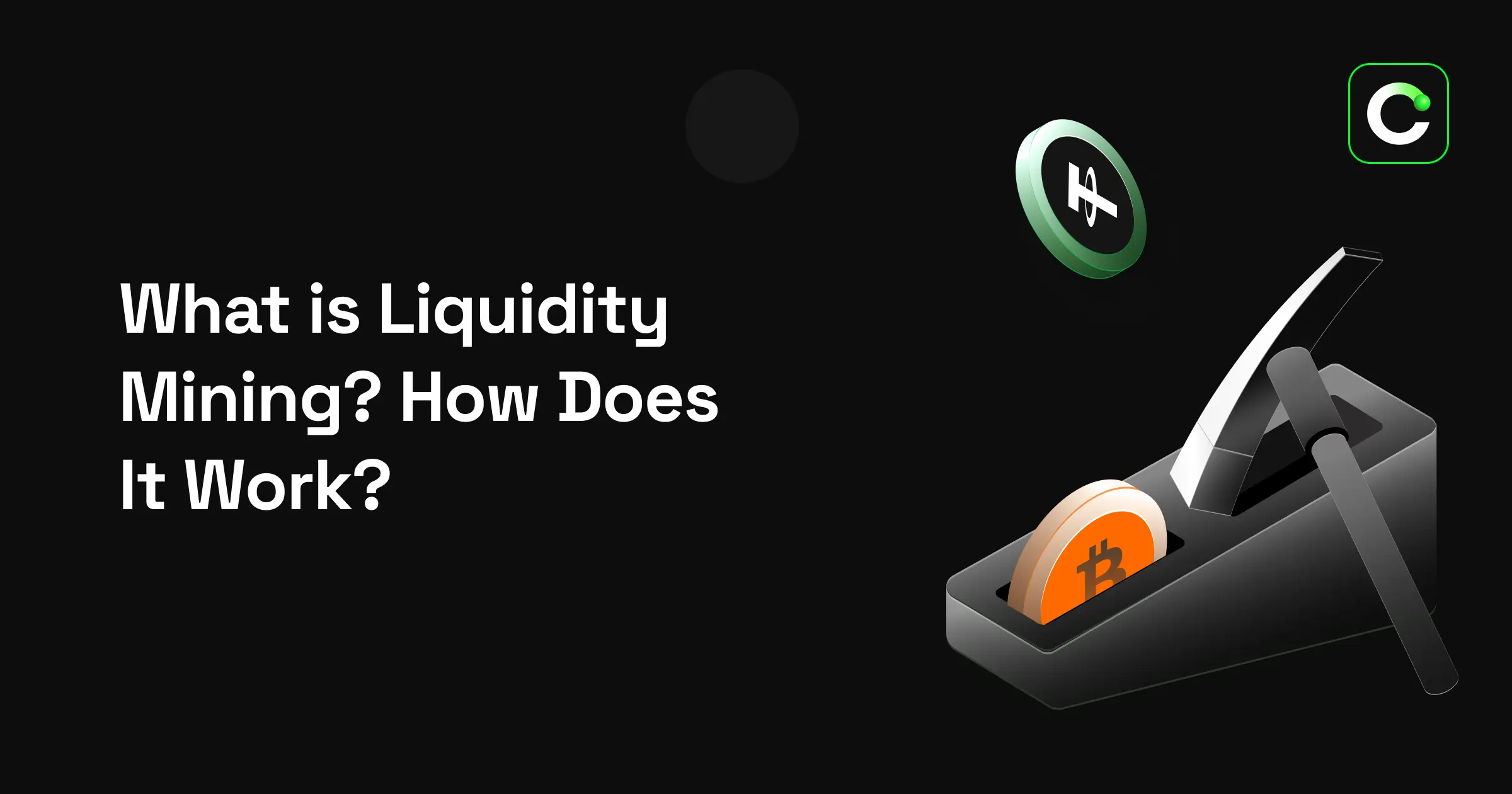What is Liquidity Mining? How Does It Work? 

Cryptocurrency Exchange

In the cryptocurrency ecosystem,
liquidity mining is a mechanism where investors provide liquidity to decentralized exchanges in exchange for rewards. Liquidity mining not only allows for passive income but also helps DeFi projects operate smoothly and increases market depth. In this article, we will explain in detail what liquidity mining is, how it works, its advantages, and its risks. With this information, users can make informed decisions and understand the basic logic of providing liquidity.
What is Liquidity Mining?
Liquidity mining is a method where users deposit their crypto assets into a liquidity pool to earn a share of trading fees and protocol-distributed token rewards. This process plays a critical role in the growth of DeFi platforms, since liquidity pools ensure that trading operations occur quickly and seamlessly.
When investors contribute to a
liquidity pool, they receive reward tokens offered by the platform. These rewards motivate users to provide liquidity while helping projects increase trading volume and expand their user base. Liquidity mining is a method not found in traditional finance models and offers passive income opportunities for both beginners and experienced traders.
What is Liquidity?
In crypto markets, liquidity refers to an asset’s ability to be quickly and easily bought or sold. A
token or coin with high liquidity can be traded without significant price loss, ensuring smooth market operations. Low liquidity, on the other hand, can lead to price fluctuations and slippage during trades. In both centralized and decentralized exchanges, liquidity is crucial for healthy market functioning. In the DeFi ecosystem, liquidity pools allow users to contribute assets, supporting the market while earning rewards.
What is DeFi Liquidity Mining?

DeFi liquidity mining allows users to deposit token pairs (e.g.
ETH/USDT) into a platform and earn rewards. Users receive LP tokens in return for their contribution. These tokens prove their participation and provide both a share of trading fees and additional protocol incentives.
One advantage of DeFi liquidity mining is the ability to earn income without relying on central authority. For example, an investor can deposit ETH and USDT tokens into a platform, share trading fees with other users, and earn extra incentive tokens from the protocol. This mechanism increases liquidity in the
DeFi ecosystem and helps trades occur faster with minimal slippage.
How Does Liquidity Mining Work?
Step 1: Depositing Assets Users deposit their crypto assets into a designated liquidity pool. These pools are managed by decentralized exchanges and provide the necessary liquidity for seamless
trading.
Step 2: Receiving LP Tokens Users who provide liquidity receive LP tokens in return for their contribution. These tokens represent the user’s share and are essential for reward distribution.
Step 3: Reward Distribution Trading fees and protocol-determined rewards are distributed based on each user’s contribution. For example, if a user contributes 5% of the total liquidity, they receive 5% of the earned trading fees.
This process benefits both users and projects in the DeFi ecosystem. Users earn passive income while projects gain higher liquidity and trading volume.
Benefits of Liquidity Mining
Liquidity mining offers various advantages for both investors and DeFi projects. Without giving investment advice, these benefits include:
-
Passive Income Opportunity Liquidity providers receive LP tokens and a share of trading fees. Some platforms also distribute additional tokens as liquidity mining rewards, allowing users to earn income without active trading.
-
Contribution to Market Liquidity Liquidity mining ensures fast and smooth trading in crypto markets. Without sufficient liquidity, slippage and delays can occur. Providers help stabilize the market, enabling other traders to execute trades more efficiently.
-
Support for New Projects Liquidity mining helps new tokens and projects obtain market liquidity. Early contributions can support the project and potentially earn extra rewards.
-
Flexible and Decentralized Finance Experience DeFi liquidity mining allows income without a central authority. Users can withdraw and redeploy liquidity as they choose, providing flexibility not found in traditional financial tools.
-
Learning Risk and Reward Balance Liquidity mining helps investors observe risk and reward ratios across different pools, gaining insights into stable pools and higher-yield protocols.
Liquidity Mining vs Other Investment Strategies
Liquidity mining is one of many strategies in the crypto ecosystem. Comparing it with other methods helps understand its pros and cons. CoinTR does not provide investment advice, but both beginners and experienced traders can research and understand these strategies themselves.
Liquidity Mining vs Staking
Staking involves locking crypto assets to secure a network or validate transactions. Liquidity mining provides liquidity to decentralized exchanges, earning shares of trading fees and additional token rewards.
| Feature | Liquidity Mining | Staking |
| Risk | Token price fluctuations and slippage risk | Lower risk; yield fluctuations are limited |
| Earning Potential | Higher potential in high-volume pools with attractive rewards | Provides stable and predictable income |
| Flexibility | Ability to change contribution and withdraw liquidity | Usually requires locking for a set period |
Liquidity Mining vs Yield Farming
Yield farming involves depositing tokens into multiple DeFi platforms to maximize returns. Liquidity mining can be part of yield farming since many strategies involve contributing liquidity.
| Feature | Liquidity Mining | Yield Farming |
| Goal | Short- and long-term passive income | Short-term, high-yield opportunities |
| Diversification | Typically single platform or token pair, can diversify using LP tokens | Diversify across different platforms and token pairs |
| Complexity | Simple, passive income method | More complex, requires continuous monitoring and strategy |
Risks of Liquidity Mining
As with any investment strategy, liquidity mining carries risks.
-
Price Fluctuations (Impermanent Loss) If token prices change relative to the deposit time, LP token withdrawals may be worth less than expected, especially in highly volatile pairs.
-
Protocol Risk DeFi platforms operate via smart contracts. Security flaws or errors can put deposited assets at risk. Users should review platform reliability and audits.
-
Liquidity and Market Risk Low total liquidity or large withdrawals can affect pricing and reward distribution. Market downturns can also reduce LP token value.
-
Regulatory and Legal Risks DeFi regulations are not yet fully established. Users should follow their country’s crypto and DeFi laws. Regulatory changes may impact liquidity mining activities.
-
Platform Changes or Closure Some protocols may change reward programs or rules or close entirely. Users may not receive expected rewards and may have to wait to withdraw assets.
Legal Notice
The information, comments, and evaluations contained in this content do not constitute investment advice. This content is not intended to be prescriptive in any way and is intended to provide general information. It does not constitute investment advice. CoinTR cannot be held responsible for any transactions made based on this information or any losses that may arise.
Recommended
- Cryptocurrency ExchangeWhat is a Stablecoin? 2025 Stablecoin List The cryptocurrency market is known for its high volatility, posing significant risks for investors. Stablecoins provide a secure alternative by maintaining a stable value. Typically pegged to fiat currencies, precious metals, or other assets, stablecoins serve as a safe haven for investors and traders. But what is a stablecoin, how does it work, and what types exist? Let’s dive into the details. What is a Stablecoin? A stablecoin is a type of cryptocurrency designed to maintain a stable value,
2024-11-24
- Cryptocurrency ExchangeWhat are Bear and Bull Markets? In financial markets, the terms bear market and bull market are often used to describe overall trends. A bear market represents periods of declining prices, while a bull market refers to rising trends. These terms are particularly important in the cryptocurrency market. But what exactly is a bear market, what is a bull market, and how long do these periods last? Here’s a detailed guide. What is a Bear Market? A bear market is a period when asset prices experience a prolonged decline, typically
2024-11-24
- Cryptocurrency ExchangeWhat is Blockchain Technology? Blockchain is a digital ledger technology where data is stored on a distributed network without the need for central authority. As the backbone of cryptocurrencies such as Bitcoin, blockchain is now being used not only in the financial world but also across many different industries. Blocks record transactions, and each block is linked to the previous one, forming a chain. This structure makes data immutable, tamper-proof, and transparent. Key Features: Decentralization: Not controlled by a s
2024-11-28


